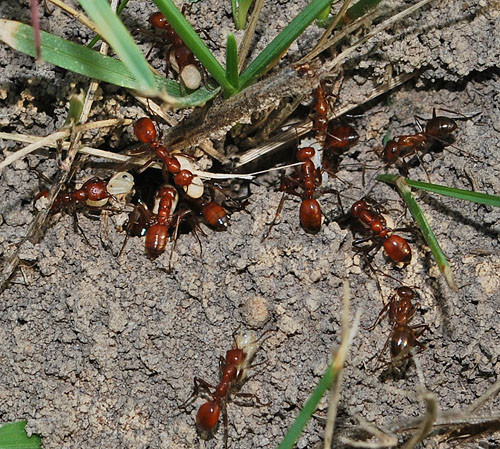James Trager writes in this week with a request and a photo:
I have been interested in Polyergus (âAmazon antsâ, see here) since childhood, when I first had the good fortune to observe them on summer afternoons in northern New Mexico. After decades of intermittent field observations and microscopic examination of specimens of these ants from various parts of the USA and Eurasia, and various interactions with other researchers on this group, I came to the conclusion that a taxonomic revision of the group is necessary.
Some background: Linda Goodloe, in her 1986 City University of NY dissertation and two resulting 1987 publications in the journal Psyche, first reported on brood-raiding and colony-foundation host-specificity in Polyergus âlucidusâ. In the mid 1990âs, I collaborated on specimen acquisition with Finnish researcher Riitta Savolainen, and she kindly shared her subsequent analysis in the form of unpublished cladograms for both the parasite and host ants, yielding roughly congruent phylogenies for the Polyergus and Formica involved. Later, Bono, et al. (2007 Biol. J. Linn. Soc. 91: 565-572) wrote that there were genetic differences between Polyergus âbrevicepsâ associated with different Formica fusca-group hosts. In another 2007 paper on which I was coauthor with Joshua King (http://insectscience.org/7.42/), we reported on differences among Polyergus âlucidusâ with different Formica hosts in northern Florida. Collectively these studies indicate that the current taxonomy does not adequately represent the species diversity in this genus.
A couple of years ago I began accumulating a standard set of metrics of Polyergus specimens, sorted by host, and the results have strengthened my view that there are more species than names available for this group. Coincidentally, a participant in Ant Course 2007, U.C. Berkeley grad student Candice Torres, started a sequence-based phylogeographic and host association study of Polyergus about the same time, and since meeting we have been trying to accumulate properly preserved specimens of Polyergus and hosts (from the Polyergus nest) that we can divide for our respective studies.
Though I hope to finish writing the morphology/ecology based revision over the next year and Candice hopes to graduate some year soon, we are still interested in acquiring new material of Polyergus/Formica, preferably killed in 90-100% ethanol (95% is best), or at least placed in it immediately after killing by freezing, in weaker alcohol, or in a cyanide kill jar. Of particular interest are specimens originating from areas where we or other colleagues have not been able to collect. These include the North American West Coast (any welcome, but especially from south of lat. 36.5 N), the Great Plains and Great Basin of the USA, anywhere in Canada or Mexico, or Japan, Korea, China and Mongolia (where the Polyergus species are black instead of the accustomed red). Ten to 20 Polyergus worker specimens from the nest, and 5-10 Formica specimens from the Polyergus nest should be put in the same vial. A particular deficiency is specimens with F. neogagates-group hosts. Specimens of both species collected from a host nest being raided will also be of interest, but must be clearly labeled as such. So, if you know of nests that can be visited and collected in this manner, or already have such material that can be provided for study, please communicate to james.trager ((at)) mobot.org and I will provide a mailing address.

Polyergus lucidus returning from raid

Hi James,
I was too at the Ant course 2007, and I probably have some Polyergous still in my samples from the course field trips. But as Candice was there, there are probably the same, even maybe from the same colony... But if that can help, I am willing to send them.
Marie-Julie
Marie-Julie:
You will not be surprised to learn we have a good amount of material from Arizona, including, as you say, some from those same colonies we collected on that day's field trip. Soem from Canada would be lovely, though!